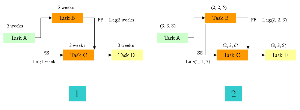Risk management - Production example
Production example
We will look at a simple PRODUCTION EXAMPLE. It doesn’t really matter what the example represents it is the principle that is important.
I’m sure you will find plenty of examples in your own sphere of expertise.
This example follows the ‘simple network’ that we saw earlier [see simple network].
In this scenario both pathways are required (task B and C). They will each have a probability of 100%.
Let us assume we are constructing an item which will be complete when Task D is complete.
To do this we buy in specialised parts from a SINGLE source.
The process would be:
Task A: Construct the first stage using part 1.
Task B: Construct the second stage (part A) using part 2.
Task C: Construct the second stage (part B) using part 3.
Task D: Construct the final stage by putting together the second stages parts A and B.
As a first pass the project team may well produce a simple activity network as in (1) in the diagram.
The experiences of the team may well assign durations to the tasks as indicated in (1).
On this basis the completion of Task D would take:
3 + [2 (task B) + 2 (FF lag)] + 3 = 10 weeks
After additional assessment the team considers that Tasks B and C may not be particularly straight forward.
The team suggests that another 3 weeks may be needed, pushing the completion duration to 13 weeks.
Typically, a team might add anywhere up to 20% as a contingency.
How accurate is this assessment?
Well it is difficult to know without carrying out a RISK ASSESSMENT.
It may well be that such a series of tasks is highly critical in setting a project end date.
This could make or break your reputation.
The senior management wants to feel more confident.
Let us look at the same example using 3 point estimates for the risk assessment.
The result is in activity network (2) in the above diagram.
The 3 point estimates are written such that the MOST LIKELY values are also the best guess of the project team as they really believe these durations to be correct.
However, on further thought, the team realised that there was a possibility that there may be some problem with the partly constructed items at the end of Tasks A, B and C.
Testing would be required and there was a good chance that problems would occur and the external parts supplier would need to assess and repair the problem.
After repair and when it returns, the part may need some additional testing before proceeding.
The expanded activity network is shown next [see production example part 2].



